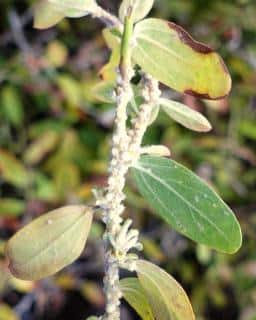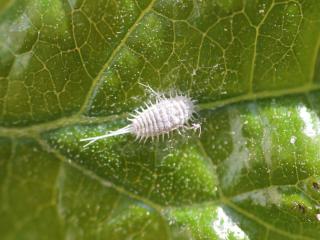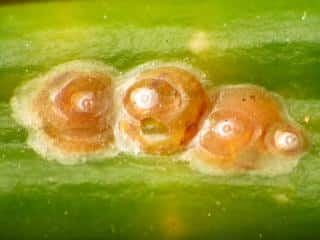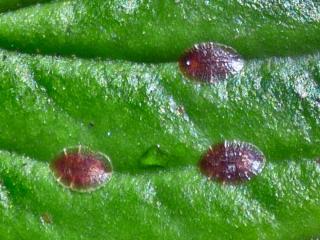

Scale insects like mealybugs are among the most common parasites on indoor plants.
Quick scale insect facts
Name – Coccidae, Pseudococcidae, Diaspididae
Lifespan – up to a year (dormant in winter)
Size – from 1/16th to 1/4th inch (1-5mm)
They can also be found in the garden at the end of spring, during summer, and in fall. The damage they inflict is variable, as are also the shapes they take to hide.
→ Delve deeper: Nature & Garden pages about scale
Scale insects usually have an oval shape, and a hard or soft waxy shell. In particular, mealybugs are covered in white or pinkish fuzz. They look a bit like cotton, snow or ashes.
Basic symptoms you’ll notice when scale starts spreading on your plants include:
 Small spots on leaves, leaf joints, stems (especially in hidden areas)
Small spots on leaves, leaf joints, stems (especially in hidden areas)Scale insects and mealybugs don’t necessarily appear in any given season. Rather, they emerge when a set of conditions is met. Scale insects like heat and high humidity.
As we’ve just mentioned, scale insects love heat and humidity.
Scale insects on a plant will often quickly contaminate nearby plants, too.
Scale insects and mealybugs must be dealt with immediately because a heavy onslaught can kill your plant.
→ Did you know? Some scale insect species are specific to a single plant or plant family. These are being investigated for use as a form of biological control against certain invasive plants.
You can control scale insects through different means. 100% organic and natural solutions exist and can be very effective.
The best recipe contains these ingredients:
 Spray this solution once a day for 3 to 4 days.
Spray this solution once a day for 3 to 4 days.→ There are also white oil-based scale insect sprays that have proven their worth. You can find them in specialized stores.
→ A spray based on fermented stinging nettle tea is also very efficient in case of mealybug attacks.
→ It is also possible to slow their spread with a powerful blast of water (as you’d do for thrips) or by cleaning leaves with a rag dipped in 90-proof alcohol and rinsing afterwards with water.
Take note: it is important to treat quickly, otherwise the pests will completely overrun the plant and it will die.
Most indoor plants such as the ficus tree or hibiscus, orchid, rose, and even succulent plants like Zamioculcas and Aloe vera can become victims.
Outdoor plants are also attacked, including citrus, lime tree (or basswood), hydrangea, oleander, lilac, olive tree, mulberry tree, red currant, peach tree, and also (less often) apple tree.
An efficient and timely treatment against scale insects and mealybugs will protect other plants in your house or garden.
There are three major families of scale insects. The treatments above work well on all of them because they can break through the scale’s protective shells and fuzz.
 1 / Mealybug (Pseudococcidae): this is the most common.
1 / Mealybug (Pseudococcidae): this is the most common.
 2 / Armored scale (Diaspididae):
2 / Armored scale (Diaspididae):
 3 / Soft scale (Coccidae):
3 / Soft scale (Coccidae):
There are 17 smaller families within the scale insect “Coccoidea superfamily“, totaling over 7,000 species.
A regular inspection of your houseplants and garden will help you catch infestations at the start. It’s very easy to contain them early on.
I noticed mealy bugs all over one of my very large house plants…after really examining it the extent of the damage is quite bad. This plant sits alone far away from any other plants…what are the chances of other house plants getting infected? I don’t usually throw plants away(literally try to save them all), but this one is just covered and stems are sticky and turning brown in places….should I throw this away and cut my losses?
Ha, mealy bugs on a large plant isn’t easy to deal with. Especially if you can’t bring it out for a thorough hosing down because it’s cumbersome. It sounds as though the entire plant has lost its luster. Were you to succeed ridding it of the buggers, as described above, it’ll take a while to recover. The main stems might stay bare since new growth typically comes from the tips, but this depends on the plant species.
To protect your other plants, it’s important to keep a minimum distance of several yards or meters between the “quarantined” one and the others. Mealybugs won’t easily travel that far. They crawl and don’t fly, so for added security you can rest the pot saucer in an even larger saucer, and keep the space between them filled with water as a barrier. However, even more important is to keep a separate set of tools and such: they’re very likely to hitch a ride and spread if you use the same tools. Or you can disinfect them thoroughly before moving on to another plant.
A good compromise it to reduce the plant severely: it’ll be easier to deal with scale on a smaller plant. Or you might throw it all out, and only keep a cutting or two – inspect these very carefully and keep them away from others for the first few weeks.
Hi I have a minature orange tree plant in my conservatory . I noticed some leaves had sticky residue on them . Some leaves had little flies on the underside of then . And also have looked at a photo of different insects they look like Coccidee soft scale . Have got quite a few off . Is there a spray I can get to kill them and keep it bug free . Have used water on a soft cloth .
Hi there Mrs Holden, the little flies might be aphids or whitefly, both also leave a sticky residue on leaves (aphids more so, actually). If in addition to that you noticed soft scale, then it would for sure help to spray. The article mentions fermented nettle, but there are other fermented teas to use. You can make your own, or purchase them in stores ready-made. They’re natural so you needn’t worry about polluting your soil, fruits or plants. And every once and a while, hose all your plants down with water to rinse off any excess product. Even though they might be natural, it doesn’t help when it’s too concentrated. Even just using plain water on a cloth every few days is sometimes enough, as you were doing. It’s important to keep doing it every few days until the infestation is wiped out.
It’s important to know that in a conservatory, pests are at an advantage compared to outdoors: warm temperatures speed their reproduction cycle, less predators, and no wind or rain to knock them off the plant. So in a conservatory you have more work of sorts, but plants also grow better as a trade-off.
Also include neighboring plants in your treatment, since some insects fly back and forth. Since new insects might come in again and again, it’s difficult for plants to truly stay bug-free.
In the long run, the only solution to make sure the pests are fully eradicated is to spread predator insects in your conservatory. They’ll be the ones doing the hunting and pest control in your stead!
My gardener has been treating my hedge for scale for some months and it’s proving extremely stubborn – have You ever heard of water blasting it off a hedge?
Hello Dale, scale insects are a difficult pest indeed. Actually, blasting water at them will succeed in getting most of the invasion under control. Usually a normal garden hose with a tip that concentrates water into a line can do the trick. However, on a long hedge it’s going to take some time: each branch must be splashed and checked for any “leftover” scale insects…
A powerwasher can perhaps help, but only if it can bet set to “not too powerful”. It also depends what type of hedge it is, some are more fragile than others. Always try on a small portion first, and wait three to four days to see if the shrub can take the pressure. Leaves will wilt and drop if they were hurt too much.
Alternatives include fermented teas that also do a great job and are quick to prepare (a couple days).
Thanks heaps
Help my ficus is dying due to an insect disease, I believe is the psila but reading this article could be mealy bugs. The texture of nests are cottony and if touched sticky. I went to a garden centre and they told me to use provado, but is not working at all. My ginseng is dying.
Hi Debora! After sharing with you on facebook, yes, it’s definitely scale insects. I always recommend brushing the bugs off with white alcohol (40% proof at least) dipped in cotton. Check out how to deal with scale insects.
The best article in plant care as far as I am concerned.
Thank you for the information about mealy bugs and brown scale. This is very helpful and works very well. It is amazing how many sites don’t mention this care in their articles.